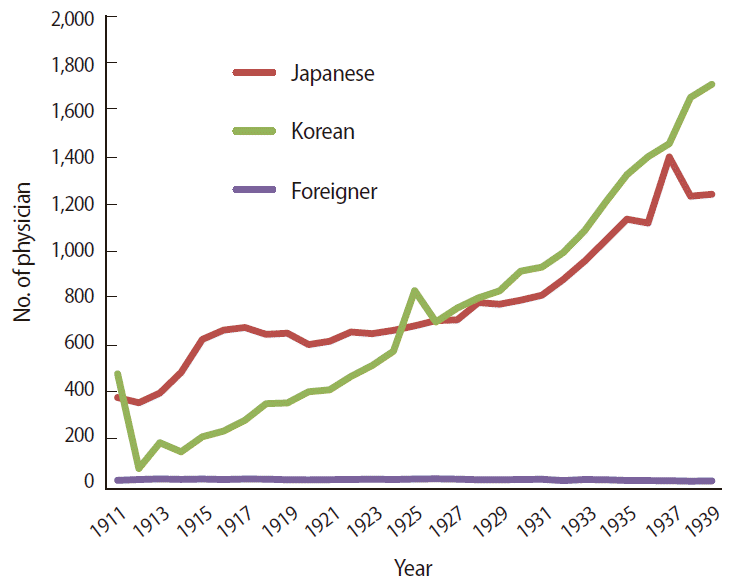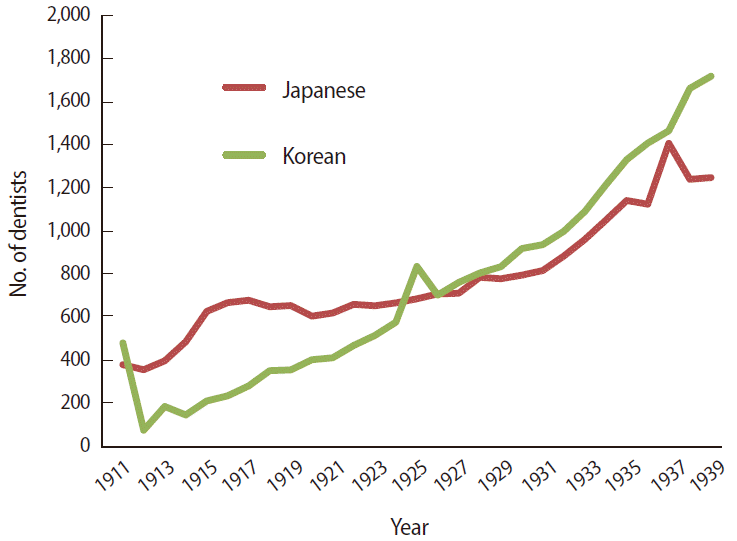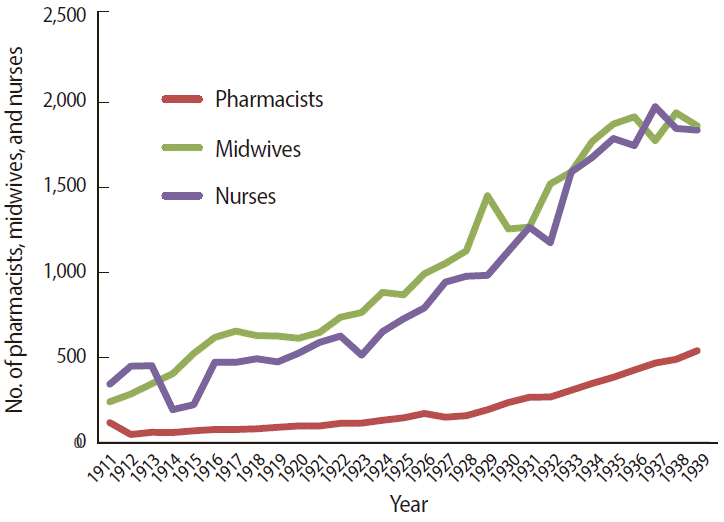INTRODUCTION
This article aims to describe the national examination system for health professionals during the reign of the Japanese Government-General of Korea (1910–1945). It mainly focuses on legal aspects of the national examination. Korea carried out the vigorous reform of its politics, economy, and society after the Political Reform in 1894 (Gabogyeongjang) by the Japanese forces. The reformation was accelerated after the Japanese annexation of Korea in 1910. The professional expert system of the health fields was also reformed beginning in 1910. That reform was mainly a transplantation of Japan’s health system—which had itself been imported from the European countries after the Meiji Restoration—into Korea. Japan experienced the excellence of modern medicine in surgical treatment after the Meiji Restoration in 1876 and also changed its traditional health system completely into a modern health system. Japan wanted to apply their experiences to Korea. Therefore, the reform of the health system during the reign of the Japanese Government-General of Korea was focused on transforming Korea’s traditional ‘Oriental’ health system to a ‘modern’ health system. During that time, the number of modern health care institutions and number of new health professionals who were educated about modern medicine rapidly increased. The modern health care system had been introduced just before the Japanese annexation of Korea. It was established as the dominant health care system, while Korea’s traditional Oriental health system was demoted to a subordinate status. The Japanese Government-General of Korea allowed physicians of traditional medicine to practice. However, as in Japan, the government did not educate any new physicians of traditional medicine. At the same time, for modern medicine, a national license was needed to practice.
There were two kinds of qualifications: one was the license without examination, which was available after graduation from designated educational institutions; the other was the license after passing the national examination. The literature published by the Japanese Government-General of Korea classified health care professionals into the following types: physicians, dentists, herbalists (Uisaeng), physicians working in a designated area, pharmacists, physicians dealing with vaccination, midwives, nurses, apothecaries, and manufacturing pharmacists. Among these, the qualification through national examination without graduating from a specific educational institution could be granted only to physicians, pharmacists, midwives, and nurses. Since the training of health professionals by regular educational institutions could not be achieved rapidly, the national examination system for health professionals was an important method of qualifying health personnel. The period of the reign of the Japanese Government-General of Korea was a dramatic turning point when the modern national examination system was established. The national examination system for health professional established at this time became the basis of today’s national examination system for health professionals in the Republic of Korea.
NUMBER OF HEALTH PROFESSIONALS
The status of health professional from 1911 to 1939 is shown in Figs. 1-3. After 1920, the number of physicians, dentists, midwives, and nurses increased rapidly. Beginning in 1926, the number of Korean physicians surpassed the number of Japanese physicians in Korea. The same phenomenon occurred for number of dentists in 1926 [1,2]. The spike in the number of Korean physicians in 1911 and decline in 1912 may be originated from the inclusion of Oriental medical doctors in 1911. The spike in the number of Korean dentists in 1911 and decline in 1912 may be originated from the inclusion of dental practitioners or any persons who practice without any certificates in 1911.
MEDICAL LICENSING EXAMINATION
In Korea, the physicians of oriental medicine provided health services until the introduction of the modern health care system; the number of people who described themselves as physicians and who were engaged in medicine was 2,600 in 1909, and most of them were the physicians of oriental medicine. In Korea, oriental medical doctors, with the exception of the more senior ‘physician officers’ (uigwan), acquired medical knowledge and techniques not by systematic education but on their own or through irregular education and training such as apprenticeships. They engaged in medical practice without any regulation of their eligibility. The Government believed that their medical techniques were backward since they did not know modern medicine. The Government tried to restrict the supply of oriental medical doctors and tried to instead foster the development of physicians who underwent modern medical education. Therefore, the Government issued medical certificates to 14 people educated in modern medical schools (13 from the department of medicine, ‘Daehan Clinic,’ and one graduate student from the Government Medical School) in 1909. This was the first medical license given to people educated in modern medicine. Even before the Japanese Annexation of Korea, physicians were trained by governmental or private medical schools, but only very few. The resident-general specifically regulated the qualifications for physicians, and tried to clarify the boundary between doctors of oriental medicine and the physicians educated about modern medicine in 1913 [3,4]. Specifically, he attempted to reduce the number of oriental medical doctors and to replace them with physicians trained in modern medicine. Due to a shortage of physicians trained by medical schools, in 1914 he allowed for licensure through examination to those who had more than five years of experience in medical practice but no regular medical education. The examination subjects represented in Table 1 [5]. The first national examination for physicians was opened from September to October in 1914. Thirteen people, 5 Japanese and8 Koreans, passed among 28 applicants (8 Japanese and 20 Koreans) [6]. The number of successful candidates in the second examination from May to June in 1915 was 17 (10 Japanese and 7 Koreans) [7]. The resident-general tried to increase the number of successful applicants by relaxing the test subjects and procedures in 1917 (Table 1) [8]. He took additional measures to relax the qualification requirements variously such as by adopting a ‘passed-subject exemption system’ in 1927 (Table 1) [9].
In the 1930s, the Japanese Government-General sensed that the harmful effect of low-quality physicians had damaged popular confidence in physicians; therefore, he tried to expand the number of physicians who graduated from medical school and tried to abolish the national examination for physicians introduced to increase the number of physicians [10]. However, due to public opposition, he could not effect this change. Instead, he strengthened the qualification required of applicants in 1934 [11]. He tried to abolish the national examination for physicians; however, due to the need for a greater number of physicians during the war, he enlarged the range of qualification and lowered the minimum qualification requirements [12]. In late 1943, the number of physicians had risen to 3,813 [13].
DENTAL LICENSING EXAMINATION
Very few dentists were practicing at the time of the Japanese Annexation of Korea in 1910. They were working without any particular distinction from dental practitioners (a lower-level professional than a dentist). In Japan, after The Dentist Act was passed, making dental practitioners’ businesses illegal, and the law was enforced, several dental practitioners moved to Korea to practice without any limitation by the Government. The number of dental practitioners was overwhelmingly greater than that of dentists at the beginning of the Japanese Government-General of Korea. The Japanese Government-General of Korea distinguished qualified dentists from the unqualified according to the Regulations on Dentists in 1913 [4]. Because the dental school specified in these rules was established in 1922 and there was no provision for granting dental licenses national examination, the Government seemed to be uninvolved in the training and production of dentists. This is believed to be for the protection of Japanese dental practitioners. At that time, since there were very few dentists in Korea, the government allowed dental practitioners to perform tooth implants [14]. The Japanese Government banned tooth implantation by dental practitioners in Japan but legalized it in Korea. When the number of Japanese residents spiked, the Japanese Government-General of Korea decided to implement a national examination for dentists as a way to increase the number of dentists in a short period of time in 1921. He added the provision that the license would be granted to whomever passed the national dental licensing examination, of which the subjects are shown in Table 2 [15]. The first national dental licensing examination was conducted in September 1921. The qualification requirements of applicants and the examination subjects were then changed. Just as for the medical licensing examination, the government tried to abolish the national licensing system and increase the number of dental schools; however, this failed due to society’s need for more dentists during the war [11,16,17,18]. The number of dentists greatly increased after the national examination for dentists was established (Fig. 2). By the end of 1943, there were 1,190 dentists [13].
PHARMACY LICENSING EXAMINATION
At the time of the Japanese Annexation, there were very few qualified pharmacists in Korea. Drug merchants checked patients directly and prepared some medicine routinely without a physician’s prescription. The roles of physicians, pharmacists, and drug vendors were not clearly distinguished. Because of the drug merchants’ handling of morphine and cocaine and their arbitrary medical practices, the Japanese Government-General of Korea developed regulations on health professionals dealing with drugs in 1912. They created distinctions among the traditionally mixed roles of health professionals related to medicine and strengthened the qualification requirements of each [19]. Health professionals related to medicine were divided into pharmacists and drug merchants under the Korean Empire; however, they were subdivided into pharmacists, drug merchants, drug manufacturers, and medicine sales people under this ordinance of control. The pharmacists were those who mixed medicines according to a physician’s prescription. The drug merchants were those who sold drugs. The drug manufacturers were those who manufactured and sold chemicals, and the medicine sales people were those who prepared, retailed, or imported patent medicines. In addition, the government announced the national pharmacy licensing examination in 1916 (Table 3) [20]. The national examination for pharmacists specified by “The National Examination Rules for Pharmacists” was first conducted in early October 1916, and one Japanese passed in knowledge part and five Japanese passed both the knowledge and practical parts [21]. The government founded a school of pharmacy in 1925 that became Gyeongseong College of Pharmacy in 1930 to supply pharmacists. Just as for the medical and dental licensing examinations, The Government later tried to abolish the national licensing system by examination and tried to increase the number of pharmacy schools without success [11,13,18]. There were 748 pharmacists at the end of 1943 [13].
MIDWIFERY LICENSING EXAMINATION
Because Koreans traditionally tended to avoid others’ help during childbirth until the Japanese Annexation, very few professional midwives existed in 1910 (20 Korean midwives and 172 Japanese midwives) [22]. The Japanese Government-General of Korea established the department of midwifery services in the Japanese Government-General of Korea Clinic School and trained midwives; however, it aimed to undertake the urgent task of training midwives to serve the increasing numbers of Japanese residents and the need for midwives in the provinces after the Japanese Annexation. To alleviate the short supply of midwives from 1913, every national clinic called ‘Jahye Clinic’ trained midwives [23]. The department of midwifery and the department of nursing of the national clinic provided regular courses and a five-month midwifery education course. ‘The Rules for Midwives’ was enacted in July 1914. In addition, ‘The National Examination Rules for Midwives’ and ‘The Regulations for Midwives’ Training’ were enacted [24]. The subjects of the national midwifery licensing examination are shown in Table 4. In 1933, the Japanese Government-General of Korea strengthened the qualification requirements so that only people who took academic classes in midwifery for at least one year could take the examination. The number of midwives had been increasing since 1914. The number increased more than three-fold from 192 in 1910 to 620 in 1919 (Fig. 3), and it was 2,095 in late 1943 [13].
NURSING LICENSING EXAMINATION
The demand for nurses had risen due to the increased number of medical colleges and physicians since the Japanese Annexation in 1910. There were 442 nurses (402 Japanese, 32 Koreans, and 8 foreigners) in 1912 [22]; however, there were no regulations about their qualifications at that time. The Japanese Government-General of Korea established regulations on the training of nurses and their licenses to control their qualifications in 1914 [25]. Nursing licenses were provided to graduates of nursing colleges or to those who passed a national nursing licensing examination. The subjects of the nursing licensing examination were represented in Table 5. Beginning in 1922, the national nursing licensing examination was limited only to those who had taken academic classes in nursing for at least one year, and the number of subjects on the test was significantly increased to make the test equivalent to the subjects of the test in Japan. After that, the system was revised to bring the test in Korea to the level of the Japanese ‘Rules for Nurses.’ The number of nurses increased dramatically once the examination was established (Table 1), and it was 2,462 by late 1943 [13].
CHANGES AFTER THE ENACTMENT OF THE KOREAN MEDICAL ORDINANCE
In the late period of the Japanese Government-General of Korea, the system of mobilization of its people and its entire industrial capacity toward military ends was accelerated due to the war. In medical health fields, the basic regulations for health were prepared on the basis of enactment of ‘The Korean Medical Ordinance’ in 1944. This contained basic regulations of the types of health professionals, their examination and licensing, medical treatment, guidance and supervision for health professionals, and associations for physicians and dentists [26]. There was a change in the examination subjects of the medical and dental licensing examinations (Tables 6, 7) [27]. ‘The Korean Medical Ordinance’ remained in effect from the liberation from Japanese rule in August 1945 to the enactment of the National Medical Service Act in July 1951.
The Japanese Government-General of Korea tried to abolish or minimize the examination system for physicians, for dentists, and for pharmacists; however, this policy could not be maintained due to the Second World War. The government relaxed the qualification in 1943 and again in 1944 [28]. A person who had no professional experience or a sufficient academic background could take the national examination in 1944; therefore, the qualification standards for physicians, dentists, and pharmacists at the end of the Japanese Government-General of Korea had regressed since the establishment of each of the qualifying examinations.
CONCLUSION
The modern health system introduced from 1884 had become dominant health system, while the traditional Oriental health system was subordinated. Health professionals were categorized into physicians, dentists, midwives, nurses, and pharmacists. The Japanese Government-General of Korea established a licensing system for health professionals in order to standardize the qualifications for the health professions. Licenses for health professionals were provided not only to graduates of specific educational institutions without taking the national examination but also to people who passed the national examination. Later the rapid expansion of the number of health professionals became necessary. Since the demand for health professionals in the Second World War period had increased, the importance of the national examination became much greater. The establishment of the national examination system during the Japanese Annexation period brought the following positive results: prevention of damage done by medical practitioners whose qualifications and quality had not been verified; establishing the quality of health services above minimum requirements; and increasing the availability of health services. Through the licensing system for health professionals during this period, traditional health services were effectively abolished. The health care system was dramatically reorganized into the modern medicine-based system. This national licensing examination system became the foundation of the present licensing examination system in Korea.




 PDF
PDF Citation
Citation Print
Print







 XML Download
XML Download